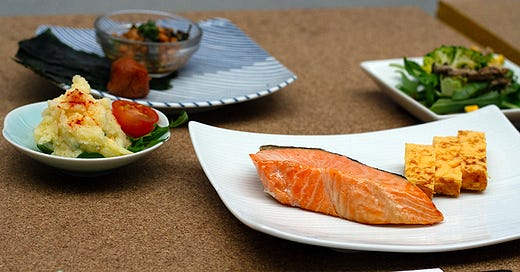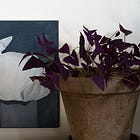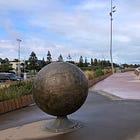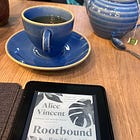Hi there and welcome to another crumby feast of… content?
We’ve got a jam-packed edition, so let’s launch straight in to talking about the finer things in life – books, plants and delicious meals.
What was cooking in April
The tail end of March brought with it the Melbourne Food and Wine Festival. I have lived in Melbourne for almost nine years, allegedly love food and yet have never attending anything at MFWF; not from lack of wanting, more that Melbourne always has too much going on at once and it’s impossible to experience everything.
This year, I was both determined and prepared enough to secure tickets to two events.
The first was a walking tour through the suburb of Sunshine, around 20 minutes west from Melbourne’s CBD. Sunshine is a multicultural hub, where you can find all kinds of delicious food – Ethiopian, Vietnamese, Iranian, Korean, Indian, Nepalese, Japanese, Chinese – you name it, it’s there.
This tour, led by local food writer Richard Cornish, saw us starting at Chingu Korean BBQ for some delicious, well, Korean BBQ. Way, way too many plates were brought out, heaped with corn cheese, japchae, fried tteok-bokk, bulgogi rice, kimchi soup, fried chicken, Korean beer. So much food and it was only the ‘appetiser’.
None, I say, none of this helped quench my long held desire to travel to South Korea with an empty belly and hopeful heart.
The ‘main’ meal was presented to us at Afghan Shaheen Restaurant, a little further up the main strip. I believe I’ve dined on Afghani food once before, during a period where I briefly lived in the Middle East. It isn’t the most complicated fare – rice with currants or herbs, paired with tender veggies in curry or perfectly smoked meat. I wish I hadn’t stuffed myself so thoroughly at Korean BBQ, so I could have enjoyed it more.
Somehow we had room for afters, stopping in at Homm Dessert Sunshine. I’d describe their plates as… hectic. I had a very tasty pain perdu with taro puree, but a lot of the desserts are served as an event.
And then, the night was complete and we rolled ourselves home.
Round two of the festival was a workshop at Collingwood institution Cibi – a cafe and most dangerously, a design store selling beautiful wares. We were hustled out back to be shown how they put together their Japanese breakfast; from how they make the dashi that forms the base of their miso soup, to the ideal technique for cooking a perfect roll of tamagoyaki (Japanese omelette, which I’m thinking now may be quite nice to make as a brekky while camping… must explore this further). The breakfast is delicious, consisting of everything from grilled salmon to the decidedly decisive dish natto (fermented, sticky soy beans). Although I must say it was slightly torturous to talk about food from 9am on a Saturday, and then not settle in to eat anything until close to 11am!
So that was MFWF done and dusted finally on my part. I look forward to being prepared for next year’s festival.
What was booking April
This month in books started off slow, but then I caught a vicious virus mid-month, which was then followed by Easter. So, on the upside, there was plenty of time for reading? Got through a few library books and victoriously, some of my TBR pile!
After splitting my time between Goodreads and The Storygraph for years, I finally bit the bullet and deleted GR for good. See what I’m flipping through in real-time on the Storygraph.
I’m also quite keen to read more poetry. In recent years I’ve only read Evelyn Araluen’s Dropbear and Ellen van Neerven’s Throat, which are both excellent and I’d like more, please. If you have any recommendations for great poetry collections, please let me know in the comments.
Books read
These were some of my favourites from the month.
A Life of One’s Own: Nine Women Writers Begin Again by Joanne Biggs (library)
I do love these sorts of books, where memoir is mixed with biography. Author Joanne grapples with her own divorce and resetting of life against the backdrop of the trials and tragedies of notable female writers, such as Sylvia Plath, Virginia Woolf, Simone de Beauvoir and Toni Morrison.
Words to Sing the World Alive: Celebrating First Nations Languages edited by Jasmin McGaughey (library)
This beautiful, generous book is a sharing of different First Nations words, across a range of languages – words that each mean something to the writer. ‘Australia’ was flush with Indigenous languages before European invasion, many of which are now considered extinct, due to very deliberate measure to force assimilation and frankly, widespread genocide throughout the country since 1788. There is power in reclaiming words and language. I felt very emotional several times throughout the reading of this book.
Breath by James Nestor (eReader)
I read this book as part of a breath workshop I was attending at my local yoga studio and it was very fascinating. James Nestor indulges in a bit of gonzo journalism and talks to some experts, hoping to discover why we breathe so badly as a society, and whether there’s anything we can do on an individual level to get our breath back to where it should be to not only survive, but to thrive.
Fire and Air by John Boyne (library and ARC)
John Boyne’s ‘Elementals’ series has been a delight to read, in a depressing way as they’re all kinda downers. Fire was quite possibly the most disturbing of the lot, with a narrator you both sympathise with and recoil from. While Air is a fitting and maybe also hopeful end to this collection of novellas.
Currently reading and listening to:
Memorial Days by Geraldine Brooks (library book)
The Private Island by Ali Lowe (library book)
Mean Streak by Rick Morton (audio book)
Books bought
Very much of a certain theme this month.
The Old Ways: A Journey on Foot by Robert MacFarlane
Dog Songs by Mary Oliver
Findings by Kathleen Jamie
Sightlines by Kathleen Jamie
Plant profile: Dandelion
If you’re new here, let me introduce you to this section. I’m conducting a monthly examination of common edible ‘weeds’ and wild foods around us.
The humble dandelion is a true superstar of the plant world. Prolific in its growing and found around the world, the leaves, root and flower of the plant are all edible, and can be eaten raw, cooked or blanched.
Named for the jagged edges of the leaf, like lion’s teeth, dandelion are apparently one of the most nutritious greens on offer.
What does dandelion taste like? Slightly bitter and peppery, although the flowers, when picked at the right time, have a sweetness to them. The leaves can be incorporated into many different dishes, the way you’d use herbs or greens. The roots can be used to make tea, or as a coffee substitute.
Dandelions do have some lookalikes in the plant world, so make sure you familiarise yourself with it, before you start harvesting. The best time to pick them for consumption is right after they bloom, as that’s when they’re at their tastiest.
There are a heap of recipes available online, but some you can consider include:
Using the leaves as you would any other greens (salads, smoothies, soups, etc).
Throwing the flowers into a garden salad.
Roasting the roots to make tea, or coffee.
Creating a tincture out of the roots, to make the most of the plants many nutrients.
Chucking the leaves across a pizza.
Making a pesto.
Creating a salve out of the flowers.
When foraging any wild plant, consider the honourable harvest. This is where you introduce yourself to the plant, and ask if you can take a portion of it. If it yields, it’s acquiesced. If not, maybe it doesn’t want to be harvested just yet and perhaps that’s something worth noting and moving on from. Although dandelion is a bit weedy, so pulling the whole plant out in this instance isn’t always the worst thing.
And as always, be safe. Avoid plants growing roadside and check with local council about their use of pesticides. Make sure you wash everything thoroughly and properly, removing any soil and bugs that may be clinging to the plant.
The safest bet is usually any ‘weeds’ growing local to you, so long as your soil is okay to eat from.
Next time we’ll be talking about a tree that has been popping berries off like mad here in Oz – the Lilly Pilly.
And more on foraging coming your way probably next week, if I stick to my editorial calendar. Update: I didn’t, but my post on foraging is still went live within the month, in any case.
In case you missed it
An attempt to bring a bit more art and creativity back into the day to day:
A wrap up of some of the nicest short hikes in and around Melbourne:
Another experiment – this one hopes to ditch the smartphone indefinitely:
That’s it for April. May is another month with five Thursdays, so I’ll guess we’ll meet on five occasions before the next crumbs. Wrapping up a few things before we launch into winter, the season no one likes but everyone should feel good about.
See you next week. ‘Til then stay well, well-fed and especially well-read.
-Celine
Thanks for reading! If you think this newsletter is quite okay, it can help quite a lot if you hit 💚 or even leave a comment – or forward it on to a like-minded friend.
Read past crumbs:
As this edition contains notes about wild foraging, I must state that I am not a nutritionist, dietician or any sort of medical expert. As with any kind of urban foraging, proceed with caution and consume at your own risk – What’s Cooking with Celine cannot take responsibility for any reader becoming ill after eating wild food.
Most links in this missive will take you to YourBookstore.io. This very handy website allows you to shop and support independent Australian bookstores. Give your local some love, or request a copy from your nearest library.













I could live on a diet of exclusively Korean food. So many wonderful flavours mmm
I just have to say that Breath changed our lives. Sleep tape trained my husband to stop mouth breathing and snoring! His sleep apnea (very mild to begin with) is gone and he only snores when he's on his back. I found the book to go off the deep end a bit in the second half (like running long distances only breathing through his nose!) and I lost interest, but it really brings home the importance of breath and breathing properly!